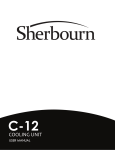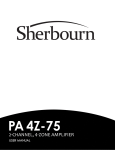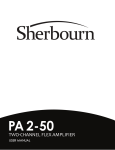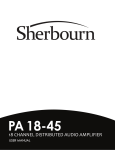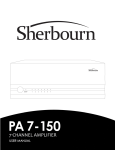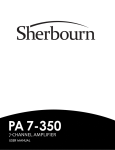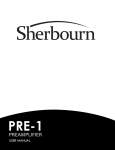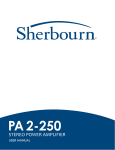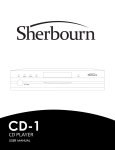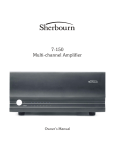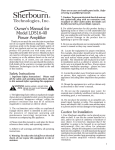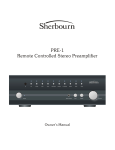Download Sherbourn Technologies CD-1 Specifications
Transcript
Important Safety Precautions and Explanation of Symbols ! The exclamation point within an equilateral triangle is intended to alert the user to the presence of important installation, operation, and service instructions in this manual. The lightning flash with arrowhead symbol within an equilateral triangle is intended to alert the user to the presence of uninsulated dangerous voltages within the enclosure that may be of sufficient magnitude to constitute a risk of electrical shock to the user. Please read this Installation and Operation Manual thoroughly before attempting to install, configure, or operate the Sherbourn C-12. After successful installation and configuration of the C-12, be sure to retain this manual in a safe place for future reference. Safety is a key component to a long lasting and trouble free installation. Please read and follow all instructions and heed all warnings on the C-12 and in this manual. The vast majority of the subsequent safety precautions are common sense. If you are not comfortable with the installation of audio/video entertainment equipment, you should seek the services of a qualified installation professional or call us for help. ! WARNING: To REDUCE the risk of fire or electric shock, do not use the C-12 near water or in wet locations, do not expose it to rain or moisture, DO NOT EXPOSE IT TO DRIPPING OR SPLASHING FROM OTHER SOURCES, AND ENSURE THAT NO OBJECTS FILLED WITH LIQUIDS (SUCH AS VASES) ARE PLACED ON IT. Doing so may result in damage to the C-12 and the risk of electric shock, which may result in bodily injury or death. WARNING: To reduce the risk of electric shock, do not remove the cover from the C-12 EXCEPT TO MAKE CONFIGURATION CHANGES AS DIRECTED IN THIS MANUAL. ! The Sherbourn C-12 is a cooling device and, as such, is intended to be installed in locations above equipment that generates heat. The Sherbourn C-12 may be configured to exhaust hot air in several different directions (depending on the configuration chosen), and to operate in several different modes. Do not install the C-12 in locations where the flow of air, as configured per the instructions in the manual, is impeded or blocked. Do not block vents or exhaust openings in the C-12 except as directed in this manual to implement the chosen configuration. Improper configuration of the C-12, or blocking of the vents or air-flow openings of the C-12, may result in improper or insufficient operation of the C-12. Doing so may result in causing either the C-12 or the equipment it services to overheat, which may result in the risk of fire, personal injury, or equipment damage. Always install your Sherbourn C-12 according to the manufacturer’s instructions and only use attachments or accessories specified by the manufacturer. Connect the Sherbourn C-12 only to an AC power adapter intended for use with the C-12, and designed for the correct line voltage in your area. Only connect the Sherbourn C-12 AC power adapter to an electrical outlet or extension cord of appropriate type and rating. Protect the AC power adapter and power cables from being pinched, walked on, or otherwise damaged. Be especially careful where the power cable exits the AC power adapter and enters the C-12 unit. DO NOT defeat the safety purpose of a grounding or polarized plug by removing ground pins or using unsafe adapters. A polarized plug has two blades - one wider than the other. A grounding plug has a third ground prong in addition to the two main conductors. The wide blade or third groundling prong is provided for your safety. If the provided plug does not fit your outlet, consult an electrician to replace your obsolete outlet. If you replace the C-12 power cord or AC adapter, use only a cord of similar type and equal or greater current rating, and only an AC adapter provided by Sherbourn for the C-12 The power adapter for the Sherbourn C-12 should be unplugged from the outlet during severe electrical storms, or when unused for a long period of time. The C-12 should only be cleaned as directed in the Installation and Operation Manual. Avoid spraying liquids directly onto the C-12 and NEVER spray liquids into the vents. Care should be taken so that small objects do not fall into the inside of the C-12. ! You should seek service for your C-12 by qualified service personnel if any of the following occur: 1. Objects or liquid have fallen or spilled into the vents. 2. The C-12 has been exposed to rain. 3. The C-12 exhibits a marked change in performance. 4. The C-12 has been dropped, or its enclosure or chassis is damaged. You should replace the C-12 AC adapter if it has been damaged or exposed to water or other liquids. NOTE: TO COMPLETELY DISCONNECT THE C-12 FROM THE AC POWER MAINS, DISCONNECT THE AC POWER ADAPTER FROM THE AC RECEPTACLE. NOTE: THE C-12’s AC POWER ADAPTER AND CABLE MUST REMAIN READILY ACCESSIBLE AT ALL TIMES. CAUTION CAUTION: TO REDUCE THE RISK OF ELECTRICAL SHOCK, DO NOT REMOVE COVER. NO USER SERVICEABLE PARTS INSIDE. REFER SERVICING TO QUALIFIED SERVICE PERSONNEL. C-12 Flex-Rack™ Cooling System Contents Important Safety Precautions and Explanation of Symbols Introduction..................................................................................................2 The Sherbourn C-12....................................................................................2 About This Manual.......................................................................................2 Mechanical and Environmental...................................................................3 Installation and Configuration......................................................................4 Mechanical Configuration............................................................................6 Performance Specifications.........................................................................9 Features....................................................................................................10 Operation...................................................................................................11 Periodic Maintenance................................................................................12 Troubleshooting.........................................................................................13 Sherbourn Technologies, LLC Ten-Year Limited Warranty........................14 Notes.........................................................................................................15 Page 1 Introduction Thank you for choosing the Sherbourn C-12 Flex-Rack™ Cooling System. Sherbourn’s innovative C-12 Flex-Rack™ Cooling System is an efficient and flexible solution to the problem of excessive heat in a rack or built-in system. Heat is a major threat to the reliability and performance of modern home theater hardware. All equipment generates heat, and many racks and other installations have little or no ventilation, so the C-12 is all that stands between your equipment and poor performance or an early death. The Sherbourn Team The Sherbourn C-12 The C-12’s three whisper quiet variable speed fans can move over 100 cubic feet of air, and it offers a wide variety of options enabling you to customize the air flow to your needs (including an external exhaust duct). Some of the features that make the C-12 so flexible include a low voltage trigger, a built-in thermal and/or external pigtail sensor, a variable temperature activation threshold, and the ability to synchronize two or more units to run at the same speed. About This Manual This manual will provide you with all the information you need to install and configure the Sherbourn C-12 Flex-Rack™ Cooling System to achieve its optimum potential. The manual also includes a brief summary of the features offered by the C-12 and a short description of how the controls work and how to perform common operations. You may wish to record serial numbers or other purchase information on the Notes page at the back of this manual. Page 2 Mechanical and Environmental SHERBOURN C-12 REAR FOAM PLUGS SIDE TOP cover plate 9” TOP & BOTTOM (external) 8.5” 16.7” C12 body FRONT (front panel removed) 2.5” 3.25” IN-ON OUT-AUTO front panel FRONT 3.5” (external) 19” 0.1825” Dimensions: 16.7” wide x 3.25” high x 9” deep (includes feet, foam plugs, no rack ears) Weight: 10 lbs / 4.5 kg (unboxed); 11 lbs / 5 kg (boxed) Rack mountable: Yes. Power requirements: 115 VAC or 230 VAC +/- 10% @ 50 / 60 Hz (with appropriate AC power module) Power consumption: approximately 10 watts (at high speed) Page 3 Installation and Configuration How the Sherbourn C-12 operates is determined both by switch settings and by mechanical reconfiguration of parts of the device. Read and follow the instructions carefully. Improper or incomplete configuration may result in unusual or unexpected behavior. In general, the electrical configuration and switch settings determine when and if the C-12 fans will operate (and at what speed), while the mechanical configuration determines the direction of air flow through the unit when the fans are active. Note: The Trigger In connector on the C-12 is a switched connector. Connecting a cable to this input operates a switch inside the C-12, so plugging in a cable that is not connected to an appropriate device at the other end may result in improper operation of the C-12. The Trigger In connection also serves different purposes depending on how the Trigger Mode switch is set. Note: The Trigger Out connector carries different signal levels depending on how the Trigger Mode switch is set. Specifically, when the Trigger Mode switch is in the Sync position, the Trigger Out should NOT be used to trigger “ordinary” 12 V triggered devices. Front panel Power Switch (On/Auto; on the left side of the front panel) This is a mechanical push button switch, which toggles between settings each time it is pressed, so it retains its setting when the C-12 is powered off. When the front panel switch is in the On position (in), the C-12 fans will run at full speed whenever mains power is applied to the C-12, regardless of the temperature or other settings or connections. When the front panel switch is in the Auto position (out), the operation of the C-12 is controlled by the Trigger Mode switch, trigger connections, and temperature sensors. Front panel LED (blue) The front panel LED is located just above the front panel Power switch. This LED will light blue when power is applied to the fans (it is not a “power LED” and will not be lit if mains power is present, but the C-12 fans are off because their temperature trigger threshold has not been exceeded). Fan Auto-On Temperature (knob on rear panel) This knob sets the temperature at which the C-12 fans switch on when in Auto mode. The temperature range is from approximately 90 degrees to 104 degrees Fahrenheit (about 32 to 40 degrees Celsius). The C-12’s fans will start running at a slow speed (and very quietly) when this temperature is exceeded, and will run faster as the temperature increases. Once the temperature exceeds this threshold by about fifteen degrees, the fans will be running at full speed and maximum air flow capacity. The fans will run only as fast as needed to maintain the desired temperature. Temperature Sensor connector (1/8” jack on rear panel) The C-12 has an internal temperature sensor mounted on the bottom of the chassis. The Temperature Sensor jack on the rear panel allows for connection of an optional magnetically mounted remote sensor. When the external sensor is plugged in, the internal sensor is completely overridden. To ensure proper operation, use only the appropriate Sherbourn supplied external sensor. Page 4 Basic Auto operation In this mode the front panel Power switch is set to the Auto position, the Trigger Mode switch is set to the 12VDC position, and nothing is plugged into the Trigger In connector. The C-12 is controlled by the temperature at the temperature sensor. (If the remote sensor is attached, then this is the temperature at that location; if no remote sensor is attached, then it is the temperature at the bottom panel of the C-12 unit. When the remote sensor is attached, the internal sensor is disabled and ignored.) When the temperature at the sensor reaches the value set by the Fan Auto-On Temperature knob, the fans will start at slow speed. If the temperature continues to rise, the fans will speed up until they reach maximum speed. (The end result is that the fans will run just fast enough to keep your cabinet at or slightly above the set temperature. When the temperature is below the set temperature, the fans will not run.) Triggered Auto operation In this mode the front panel Power switch is set to the Auto position, the Trigger Mode switch is set to the 12VDC position, and a trigger cable (from some other device) is plugged into the Trigger In connector. Note: The Trigger In connector on the C-12 is a switched connector. If you plug a cable into the Trigger In connector and don’t connect it to anything, the C-12 will NOT operate in Auto mode at all. When the trigger input is high (+12 VDC), the C-12 operates exactly as it does in Basic Auto mode (the fans start running when the temperature at the sensor exceeds the threshold temperature set by the Fan Auto-On Temperature control). When the trigger input is low, the C-12 fans do not operate. Sync mode Sync mode allows the operation of multiple C-12 units to be controlled by a single “master unit”. One unit is designated as the “master” and a second (or more) units as “slaves”. The fans in all slave units will switch on at the same time and run at the same speed as those in the master unit. All activity will be controlled by the temperature sensor and temperature threshold setting of the master unit. (All sensors in slave units will be ignored.) In this mode, the front panel Power switches in all master and slave units are set to the Auto position, and the Trigger Mode switches are set to the Sync position. A trigger cable is connected from the Trigger Out of the master unit to the Trigger In of the slave (or first slave). If there are additional slave units, then a trigger cable is connected from the Trigger Out of the first slave to the Trigger In of the second slave, and so on; this is repeated until all slaves are connected. (All slaves must be set to Auto and to Sync mode). Note: In Sync mode there should NOT be anything plugged into the Trigger In connector of the master unit. In this mode, ALL C-12 units are controlled by the temperature at the temperature sensor of the master unit. (If the remote sensor is attached, then this is the temperature at that location; if no remote sensor is attached, then it is the temperature at the bottom panel of the C-12 unit.) When the temperature at the sensor reaches the value set by the Fan Auto-On Temperature knob, the fans will start at slow speed. If the temperature continues to rise, the fans will speed up until they reach maximum speed. Page 5 Mechanical Configuration The direction of air flow in the C-12 is determined by the mechanical configuration of the unit itself. The parts involved in the mechanical configuration of the C-12 are: • Top and bottom plates - The C-12 is always operated with both top and bottom plates in place. The top plate is removed to facilitate installing the foam block or air filter behind the front panel. • Cover plate - The cover plate (metal) is used to cover the top or bottom vents to force air flow in the proper direction. One cover plate is supplied with the C-12, and it is not used in all configurations (be sure to retain the cover plate and screws in a safe place when not in use). • Fan assembly - The fans inside the C-12 are mounted on a movable carriage which allows them to be positioned against either the top or bottom of the case. Fans are moved by loosening the four large screws on the sides (two on each side), repositioning the fan assembly, and re-tightening the screws. • Filter and Foam Block - The C-12 is supplied with both a foam filter and a dense foam block, both of which fit behind the front panel vents. The filter is used when air flow through the front panel is desired; the foam block is used to prevent air flow through the front panel when it is not desired. Only one is used at once (be sure to retain the other in a safe place). To configure these, remove the top plate and insert whichever one is required, against the front panel, sliding it behind the long screws protruding from the bottom plate. Then replace the top plate by inserting the front edge first (tilt the plate and insert it so the long protruding screws “pin” the filter or foam block against the front panel rather than impaling it). • Rear plugs - The rear plugs are foam cylinders used to block the rear vents (2) when air flow from the rear is not configured. These plugs are dense foam cylinders, and are inserted by squeezing them and pressing them approximately halfway into the two holes in the rear panel (a slight twisting motion will help). • Rear exhaust hose - When air flow from the rear exhaust vents is configured, lengths of “standard 1-1/2” pool skimmer hose” are inserted into the rear vents (after removing and retaining the plugs). The hose should not include end fittings of any sort; the spiral hose should be “screwed” directly into the rear panel about two turns. Front Exhaust (bottom entry) • • • • Ensure that the filter (not the foam block) is installed behind the front grill Ensure that the cover plate covers the vents in the top plate Ensure that both rear plugs are firmly inserted Ensure that the fan assembly is in the lower position (against the bottom plate of the C-12) Rear Exhaust (bottom entry) • • • • • Ensure that the foam block (not the filter) is installed behind the front grill Ensure that the cover plate covers the vents in the top plate Ensure that both rear plugs are removed Ensure that exhaust hose is firmly inserted into the rear vents Ensure that the fan assembly is in the lower position (against the bottom plate of the C-12) Note: The maximum air flow rate of the C-12 will be somewhat reduced with this option, and will depend on the overall length of vent hose used. Using short hose runs, with as few bends as possible, will help to maximize air flow and so maximize cooling. Page 6 FRONT FILTER or FOAM BLOCK COVER PLATE (top position) TOP PLATE FAN ASSEMBLY REAR PLUGS BOTTOM PLATE COVER PLATE (bottom position) COVER PLATE (top position) FRONT EXHAUST FAN ASSEMBLY FILTER COVER PLATE (top position) REAR EXHAUST FAN ASSEMBLY AIR HOSE x2 FOAM BLOCK TOP EXHAUST (front entry) FAN ASSEMBLY REAR PLUGS FILTER COVER PLATE (bottom position) TOP EXHAUST (bottom entry) FAN ASSEMBLY REAR PLUGS FOAM BLOCK Page 7 Top Exhaust (front entry) • • • • Ensure that the filter (not the foam block) is installed behind the front grill Ensure that the cover plate covers the vents in the bottom plate Ensure that both rear plugs are firmly inserted Ensure that the fan assembly is in the upper position (against the top plate of the C-12) Top Exhaust (bottom entry) • • • • Ensure that the foam block (not the filter) is installed behind the front grill Ensure that the cover plate is completely removed Ensure that both rear plugs are firmly inserted Ensure that the fan assembly is in the upper position (against the top plate of the C-12) Page 8 Performance Specifications Air-flow capacity: >100 cfm; direct outlet; variable (maximum airflow will be reduced if long exhaust ducts are used) Cooling modes (manually selected): • • • • Bottom Entry - Front Exhaust Bottom Entry - Rear Exhaust (can optionally be ducted using 1-1/2” hose x 2) Front Entry - Top Exhaust Bottom Entry - Top Exhaust Auto-On temperature: • Variable; from approximately 90 degrees Fahrenheit to 104 degrees Fahrenheit (about 32 to 40 degrees Celsius) Power modes: • • • • Always on Auto-on (by temperature) Auto-on (by temperature) when triggered Sync mode (slave to another unit) Page 9 Features The Sherbourn C-12 Flex Rack™Cooling System offers an effective and flexible cooling solution for rack mounted equipment. Some of the features of the C-12 include: • • • • • • • • • • • Uses three high-capacity whisper-quiet 4.75 inch fans Front panel Power switch and blue LED indicator light Can be mechanically configured for front exhaust with bottom entry, top exhaust with front entry, top exhaust with bottom entry, or rear exhaust with bottom entry Front panel intake includes air filter Offers two exhaust ports and (optional) exhaust hose for maximum flexibility Includes embedded thermal sensor and (optional) remote sensor Rear panel input for remote sensor Optional synchronization of fan speeds between multiple units 12-volt trigger input Variable starting temperature (95 to 104 degrees Fahrenheit; 32 to 40 degrees Celsius)) Rack mount front panel included (removable) You can find more information about the Sherbourn C-12 Flex Rack™Cooling System on our Web site at http://www.sherbourn.com Page 10 Operation The Sherbourn C-12 is normally configured to operate automatically. In normal operation, the C-12 fans will not operate until the configured Starting Temperature has been exceeded (at the sensor). At this point, the C-12’s fans will start operating at minimum speed; fan speed will gradually increase as the temperature rises above the starting temperature. (In situations where little air flow is needed, the fans will operate at the minimum speed necessary to maintain temperature, ensuring minimum noise.) The front panel switch allows the C-12 to be manually run with the fans at full. This mode is typically used only for testing purposes. Page 11 Periodic Maintenance The Sherbourn C-12 requires very little periodic maintenance. Cleaning the C-12 air filter The interior of the C-12 (and especially the air filter) may become dusty (or accumulate lint and other debris) with normal operation. If this occurs, periodically disconnect the power, remove the top cover, and vacuum out any loose debris and dust that has accumulated (be careful to avoid damaging the interior circuit boards and wiring). The filter should be vacuumed periodically, and may be carefully washed and rinsed if necessary. Page 12 Troubleshooting If problems occur, the first step should be to verify that the Sherbourn C-12 is attached to an appropriate (Sherbourn supplied) AC adapter (“power brick”), and that the AC adapter used is rated for the local AC line voltage. Note: If a cable is connected to the Trigger Input of the C-12, but not connected to a triggering device, the C-12 will not act as expected with the Trigger switch in either position. DO NOT insert a cable into the Trigger In connector unless the other end is connected to an active device. Problem: No air flow (fans sound like they are running) • Verify that the C-12 is configured correctly (mechanical configuration) Problem: Fans never come on - even at high temperatures • • • • Verify that, if a remote temperature sensor is used, it is in the warmest spot in the cabinet Verify that the Fan Auto-On temperature control is set to the desired temperature. Verify that ONLY a remote temperature sensor is plugged into the Temp Sensor connector (plugging a trigger cable or other cable into this connector will result unpredictable behavior and possible damage to the C-12) Verify that, if a remote device is expected to trigger the C-12, the trigger signal is active and the Trigger Mode switch in in the 12VDC position. Problem: Fans run when they shouldn’t • • • • Verify that the Fan Auto-On temperature control is set to the desired temperature. Verify that ONLY a remote temperature sensor is plugged into the Temp Sensor connector (plugging a trigger cable or other cable into this connector will result unpredictable behavior and possible damage to the C-12) Verify that, if a remote device is expected to trigger the C-12, the trigger signal is active and the Trigger Mode switch in in the 12VDC position. Verify that, if the C-12 is being run in Sync mode, the C-12 unit connected to its Trigger In is also in Sync mode (and that ONLY another Sherbourn C-12 unit in Sync mode is connected to its Trigger In.) Problem: Fans come on, but air flow seems weak • • • Verify that the C-12 is configured correctly (mechanical configuration) Check if the filter needs cleaning If exhaust hoses are used, verify that they are clear of obstruction (and not too long) Problem: Fans ONLY run at full speed • Verify that, if a trigger input is used, and the C-12 is not a slave unit to another C-12, the Trigger Mode switch is not in the Sync position Page 13 Sherbourn Technologies, LLC Ten-Year Limited Warranty What does this warranty cover? Sherbourn Technologies, LLC (“Sherbourn”) warrants its products against defects in materials and workmanship. This warranty is subject to revision at any time. How long does this coverage last? This warranty commences on the date of retail purchase by the original retail purchaser and runs for a period of ten (10) years thereafter, with the following exceptions: (1) receivers (including the SR-8100, SR-8200, and SR-120), preamp/processors (including the PT-7030, PT-720C4, and PT-7020), preamplifiers (including the PRE-1), and the CD-1 CD Player (with the exception of the slot load CD engine) are covered by this warranty for five (5) years from the date of retail purchase by the original purchaser; and (2) electromechanical components, including the slot load CD engine on the CD-1 CD Player, and all fans (including the C-12 Cooling Unit), are covered by this warranty for three (3) years from the date of retail purchase by the original retail purchaser. This warranty is transferrable, upon written notification to Sherbourn, to any person that owns the warranted product, however, if ownership is transferred, the Term shall be no longer than five (5) years from the date of purchase by the original purchaser. Sherbourn warrants any replacement product or part furnished hereunder against defects in materials and workmanship for the longer of the following: (i) the amount of time remaining under the original warranty, or (ii) 120 days from your receipt of the repaired or replaced product. The duration described in the previous 3 sentences is hereinafter referred to as the “Term”. TO THE FULLEST EXTENT PERMITTED BY LAW, ALL IMPLIED WARRANTIES RELATED TO THE ORIGINAL PRODUCT AND ANY REPLACEMENT PRODUCT OR PARTS (INCLUDING IMPLIED WARRANTIES OF MERCHANTABILITY AND FITNESS FOR A PARTICULAR PURPOSE) ARE EXPRESSLY LIMITED TO THE TERM OF THIS LIMITED WARRANTY. SOME STATES DO NOT ALLOW LIMITATIONS ON HOW LONG AN IMPLIED WARRANTY LASTS, SO THE ABOVE LIMITATION MAY NOT APPLY TO YOU. A claim under this warranty must be made by you within the Term. A claim shall not be valid (and Sherbourn has no obligation related to the claim) if it is not made within the Term and if it is not made in strict compliance with the requirements of the “How do you get service?” section. What will Sherbourn do? Sherbourn will, at its option, either: (i) repair the product, or (ii) replace the product with a new consumer product which is identical or reasonably equivalent to the product. Sherbourn may provide you with a refund of the actual purchase price of the product in the event (i) Sherbourn is unable to provide replacement and repair is not commercially practicable or cannot be timely made, or (ii) you agree to accept a refund in lieu of other remedies hereunder. When a product or part is repaired or replaced, any replacement item becomes your property and the replaced item becomes Sherbourn’s property. When a refund is given, the product for which the refund is provided must be returned to Sherbourn and becomes Sherbourn’s property. What is not covered by this warranty? This warranty does not apply: (i) to damage caused by use with non-Sherbourn products, where the non-Sherbourn product is the cause of the damage; (ii) to damage caused by service or maintenance performed by anyone who is not a representative of Sherbourn; (iii) to damage caused by accident, abuse, misuse, flood, fire, earthquake or other external causes; (iv) to a product or part that has been modified after its retail purchase, where the modification caused or contributed to the damage; (v) to consumable parts, such as batteries; (vi) normal wear tear; or (vii) if any Sherbourn serial number has been removed or defaced and Sherbourn cannot otherwise confirm that you are the original retail purchaser or authorized transferee. SHERBOURN SHALL NOT BE LIABLE FOR ANY INCIDENTAL OR CONSEQUENTIAL Page 14 DAMAGES ARISING FROM OR RELATED TO ANY DEFECTS IN OR DAMAGES TO ITS PRODUCTS. SOME STATES DO NOT ALLOW THE EXCLUSION OR LIMITATION OF INCIDENTAL OR CONSEQUENTIAL DAMAGES, SO THE ABOVE LIMITATION OR EXCLUSION MAY NOT APPLY. How do you get service? In order to make a claim under the warranty, you must: 1. Call a customer service representative (“CSR”) of Sherbourn at (1-877-EMO-TECH / 1-877-366-8324). Provide the CSR with a description of your problem and the serial number of the product for which the warranty claim is being made. 2. The CSR will provide you with a returned material authorization number (“RMA”). 3. Ship the product to Sherbourn at the following address, with the RMA written in large, bold letters on the outside of the box, and with the letters “RMA” written before the number. Parcels arriving without a RMA number on the outside of the box will be refused. Sherbourn Technologies, LLC Attn: Repair Department 135 Southeast Parkway Court Franklin, TN 37064 How does state law apply? This warranty gives you specific legal rights, and you may also have other rights which vary from state to state. CERTAIN STATES HAVE ENACTED LAWS WHICH PRECLUDE THE WAIVER OF CONSEQUENTIAL AND INCIDENTAL DAMAGES AND/ OR PRECLUDE THE WAIVER/LIMITATION OF IMPLIED WARRANTIES. TO THE EXTENT YOUR STATE HAS ENACTED A LAW WHICH PROHIBITS SUCH A WAIVER/LIMITATION, ALL SUCH WAIVERS/LIMITATIONS CONTAINED IN THIS WARRANTY ARE INAPPLICABLE TO YOU. CERTAIN STATES HAVE ENACTED LAWS WHICH REQUIRE THE DURATION OF A WARRANTY TO BE EXTENDED (INCLUDING BUT NOT LIMITED TO DURING PERIODS OF REPAIR). TO THE EXTENT YOUR STATE HAS ENACTED A LAW OF THIS NATURE, THEN THE DURATION OF THIS WARRANTY WILL BE EXTENDED AS REQUIRED BY APPLICABLE LAW. Notes All information contained in this manual is accurate to the best of our knowledge at the time of publication. In keeping with our policy of ongoing product improvement, we reserve the right to make changes to the design and features of our products without prior notice. User Manual Revision 2 Page 15 May 2013




















